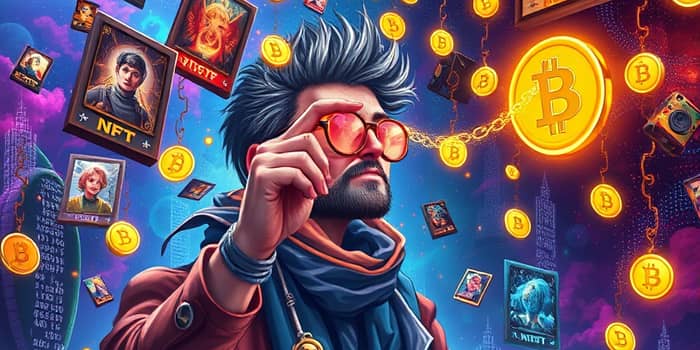In an era defined by digital innovation and limitless creativity, NFT royalties stand out as a game-changing concept. Creators worldwide are exploring new avenues to monetize their work, and NFTs have emerged at the forefront of this revolution. By embedding royalty clauses directly into a token’s code, artists can secure ongoing income streams and a renewed sense of ownership over their creations.
For many artists who once relied solely on commissions or grants, NFT royalties offer a path to independence and recognition. They transform fleeting viral fame into measurable, long-term rewards and help build a sustainable career grounded in transparent digital proof. Creators can reinvest earnings into new projects, collaborate globally, and feel assured that their intellectual property is valued beyond the initial transaction.
Definition and Mechanics of NFT Royalties
NFT royalties refer to a preset percentage of the sale price that returns to the original creator every time the Non-Fungible Token is traded on secondary markets. They are implemented through smart contracts automatically enforce payments that become part of the token’s metadata at minting. Typical royalty rates range from 5% to 15%, with the most common percentages falling between 5% and 10%.
For example, if an artist sets a 7% royalty on a token sold for $1,000, they receive $70. A subsequent resale of the same token at $10,000 would net the creator $700. This mechanism transforms one-off sales into lasting revenue opportunities, enabling creators to benefit from the growing value of their work over time.
Technical Implementation: Smart Contracts and Standards
At the heart of NFT royalties lies blockchain technology. When an NFT is minted, a self-executing agreement built into its smart contract dictates royalty rules. Standards such as ERC-2981 have emerged to unify royalty metadata across ERC-721 tokens. However, achieving universal compliance remains a work in progress.
One significant hurdle is distinguishing between genuine sales and other types of transfers, like gifts or wallet migrations. Marketplaces must integrate the royalty standard while ensuring transfers that should not trigger payments remain exempt. Until full on-chain enforcement is realized, some platforms rely on platform-level overlays to manage and distribute royalties.
Benefits for Creators
NFT royalties usher in a new era of creator empowerment. Artists, musicians, and digital designers gain direct access to global markets without traditional gatekeepers such as galleries, labels, or publishers. This democratization fosters a more inclusive creative economy.
- Consistent Income: By embedding resale royalties, creators secure earnings beyond the initial sale, establishing a sustainable source of income for digital creators.
- Ownership Retention: Artists maintain greater control over their work, dictating terms and royalty percentages upfront.
- Market Adaptability: As a token’s popularity grows, so do the creator’s returns, with no need to renegotiate contracts.
This system corrects long-standing inequities in traditional industries, where subsequent fortunes built on a creator’s original work rarely translate into fair compensation.
Economic Impact
The economic ramifications of NFT royalties are profound. In 2021, global NFT sales surpassed $25 billion, underscoring the market’s potency. Beyond headline-grabbing million-dollar auctions, thousands of independent creators now access robust earning opportunities that were previously out of reach.
These royalties have created pipelines for continuous earnings, enabling creators to allocate more resources toward their craft rather than chasing one-off sales.
Challenges and Limitations
Despite their promise, NFT royalties face several obstacles. Enforcement is not yet uniform across all marketplaces, and some platforms permit royalty bypasses, undermining the system’s reliability. This inconsistency can frustrate creators who depend on predictable follow-up income.
Furthermore, the lack of a single, universally enforced technical standard means that each marketplace may implement royalties differently. This siloed approach can confuse buyers and sellers, leading to potential disputes over which transactions trigger payments.
Environmental considerations also play a role, as some blockchain networks consume high energy. Creators and platforms are exploring greener chains and layer-2 solutions to minimize their ecological footprint.
Transformative Impact on Creative Industries
By embedding financial rights directly into digital assets, NFTs have catalyzed the rise of the emerging digital ownership economy. Consumers now purchase verifiable ownership of art, music, and other creative works rather than mere usage licenses.
- Visual Arts: Galleries and artists host virtual exhibitions where NFT collectors can trade works instantly.
- Music Industry: Musicians release tracks as NFTs, earning royalties each time a fan resells a song.
- Gaming and Virtual Goods: Digital skins and items incorporate royalties, rewarding game developers for every trade.
This multi-industry embrace signals a shift toward decentralized, creator-driven markets where value flows back to those who originate the content.
Future Outlook
As of early 2025, NFT royalties continue to reshape creator economics. Ongoing developments aim to standardize royalty enforcement and broaden marketplace adoption. Emerging protocols seek to automate the differentiation between sales and other transfer types, ensuring correct royalty triggers.
Looking forward, the convergence of NFTs with metaverse platforms, augmented reality experiences, and cross-chain standards promises to expand royalty horizons even further. Creators can anticipate a future where their digital rights are safeguarded across diverse ecosystems, fostering equitable distribution of revenues and sustained creative growth.
In this evolving landscape, NFT royalties represent more than a financial model—they embody a philosophy that honors artistic contribution, nurtures creative communities, and rewrites the traditional narratives of value and ownership.
References
- https://www.coinbase.com/learn/your-crypto/what-are-nft-royalties
- https://cryptoforinnovation.org/how-nft-royalties-work-and-sometimes-dont/
- https://www.lcx.com/an-overview-of-nft-royalties/
- https://a16zcrypto.com/posts/article/how-nft-royalties-work/
- https://tangem.com/en/glossary/nft-royalties/
- https://blog.twendeesoft.com/blockchain/nfts-market/understanding-nfts-understanding-their-impact-on-the-creative-industry/
- https://www.globallegalinsights.com/practice-areas/blockchain-cryptocurrency-laws-and-regulations/legal-considerations-in-the-minting-marketing-and-selling-of-nfts/
- https://nftevening.com/nft-royalties/










